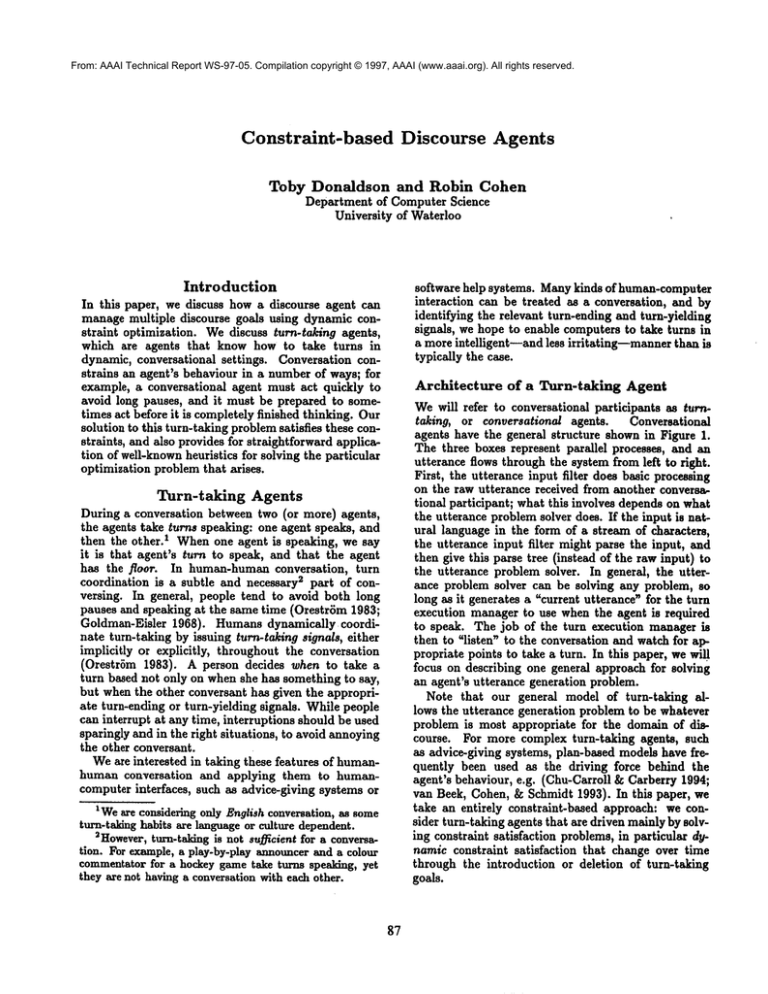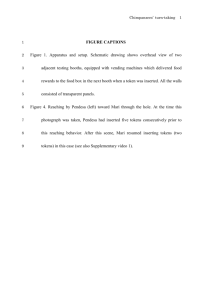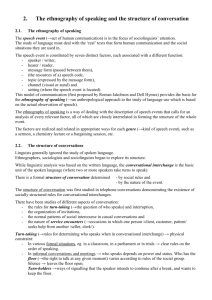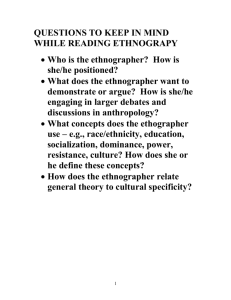
From: AAAI Technical Report WS-97-05. Compilation copyright © 1997, AAAI (www.aaai.org). All rights reserved.
Constraint-basedDiscourseAgents
Toby
Donaldson
and Robin
Cohen
Department of Computer Science
University of Waterloo
Introduction
In this paper, we discuss how a discourse agent can
manage multiple discourse goals using dynamic constraint optimization. Wediscuss turn-taking agents,
which are agents that know how to take turns in
dynamic, conversational settings. Conversation constrains an agent’s behaviour in a number of ways; for
example, a conversational agent must act quickly to
avoid long pauses, and it must be prepared to sometimes act before it is completely finished thinking. Our
solution to this turn-taking problem satisfies these conattaints, and also provides for straightforward application of well-knownheuristics for solving the particular
optimization problem that arises.
software help systems. Manykinds of human-computer
interaction can be treated as a conversation, and by
identifying the relevant turn-ending and turn-yielding
signals, we hope to enable computers to take turns in
a more intelligent--and less irritating--manner than is
typically the case.
Architecture
Turn-taking
Agents
During a conversation between two (or more) agents,
the agents take turns speaking: one agent speaks, and
then the other. 1 Whenone agent is speaking, we say
it is that agent’s turn to speak, and that the agent
has the floor. In human-human conversation,
turn
coordination is a subtle and necessary z part of conversing. In general, people tend to avoid both long
pauses and speaking at the same time (Orestr~im 1983;
Goldman-Eisler 1968). Humans dynamically coordinate turn-taking by issuing turn-taking signals, either
implicitly or explicitly, throughout the conversation
(OrestrSm 1983). A person decides 1#hen to take a
turn based ~ot only on when she has something to say,
but when the other conversant has given the appropriate turn-ending or turn-yielding signals. While people
can interrupt at any time, interruptions should be used
sparingly and in the right situations, to avoid annoying
the other conversant.
Weare interested in taking these features of humanhuman conversation
and applying them to humancomputer interfaces, such as advice-giving systems or
1 Weare considering only English conversation, as some
turn-taking habits are language or culture dependent.
2However,turn-taking is not suj~icient for a conversation. For example, a play-by-play announcer and a colour
commentator for a hockey game take turns spe~dng, yet
they are not having a conversation with each other.
87
of a Turn-taking
Agent
Wewill refer to conversational participants as turntaking, or conversational agents. Conversational
agents have the general structure shown in Figure 1.
The three boxes represent parallel processes, and an
utterance flows through the system from left to right.
First, the utterance input filter does basic processing
on the raw utterance received from another conversational participant; what this involves depends on what
the utterance problem solver does. If the input is natural language in the form of a stream of characters,
the utterance input filter might parse the input, and
then give this parse tree (instead of the raw input)
the utterance problem solver. In general, the utterance problem solver can be solving any problem, so
long as it generates a "current utterance" for the turn
execution manager to use when the agent is required
to speak. The job of the turn execution manager is
then to "listen" to the conversation and watch for appropriate points to take a turn. In this paper, we will
focus on describing one general approach for solving
an agent’s utterance generation problem.
Note that our general model of turn-taking allows the utterance generation problem to be whatever
problem is most appropriate for the domain of discourse. For more complex turn-taking agents, such
as advice-giving systems, plan-based models have frequently been used as the driving force behind the
agent’s behaviour, e.g. (Chu-Carroll & Carberry 1994;
van Beck, Cohen, & Schmidt 1993). In this paper, we
take an entirely constraint-based approach: we consider turn-taking agents that are driven mainly by solving constraint satisfaction problems, in particular dynamic constraint satisfaction that change over time
through the introduction or deletion of turn-taking
goals.
.....,..,°......................................
....,,,..,
/ ge~ra~ion~’
~GoalSelector]
CSP
variables
(workingmemory)
Figure I: The Internal
Agent.
/
Structure
trllllll
Vl V2 V3 V4 V5 V6 V7
1
of a Turn-taking
Figure 2: A constraint-based
Controlling
Agents
with
DCSPs
To highlight how we intend to use constraints to control turn-taking agents, we will use a simpler agent
model than that of Figure 1. Figure 2 shows how we
view the goal-management part of turn-taking agents.
The agent perceives the outside world, and turn-taking
goals axe created and dumpedinto a goal pool. Goals
are selected from the goal pool by the goal selector and
placed into the "working memory"of the agent, which
consists of a fixed number of slots that can hold one
goal each. These slots correspond directly to the variables of the constraint satisfaction problem the agent
solves, and the first variable holds the "current utterance", that is, the goal that the agent will try to
achieve if it is required to act this instant. The working
memoryvariables also have a fixed order of execution:
if the agent is required to act, then it will first try to
achieve the goal in Vz, then V2, and so on. This order
influences how the goal orderer performs its processing. The goal orderer continually works on arranging
the goals in working memoryin the order that breaks
as few constraints as possible. Wediscuss the operation of the goal selector and the goal orderer more
fully in a moment. Finally, we are not concerned directly with when to execute a goal; we leave that to
3the turn execution manager.
Kinds
1
utwance
",,.
turn-taking agent
- contradiction repair (i.e. reconciliation of contradictory utterances/beliefs);
* clarification goals:
- domain plan clarification
(i.e. determining the
higher-level goals behind the utterance);
- meaning clarification (e.g. requesting the meaning
of an unfamiliar word used by the speaker);
- linguistic clarification (i.e. cases where somesort
of noise, such as a spelling mistake in written discourse, has prevented the listener from clearly interpreting the utterance);
* information-seeking goals;
¯ question-answering goals.
The various kinds of constraints that determine the
ideal order of goal satisfaction are specified by the fol4lowing penalty matrix:
1 2 3 4 5 6 7
1
p p
2
p
3
4 p p p
p p
5 p p p p
p p
6
7
1 - domainplan clar. 5 - answering
2 - meaningclar.
6 - in/o-repalr
3 - linguistic clar.
? - contra, repair
4 - info-seeking
In the matrix, a p means a penalty is assigned. A
penalty is any positive value, and the penalties can be
different values. Penalties are read off by row and then
column. For example, if G, is an information-seeking
goal, and Gb is an information-repair goal, then putting
G=before Gb results in a penalty, but putting Gb before
G, does not.
of Goals
The particular types of turn-taking goals that are relevant depend upon the type of discourse in which one is
engaging. Wehave studied advice-giving settings most
closely, and have identified the following turn-taking
goal-types (this is not intended to be an exhaustive
list):
¯ repair goals:
- information repair goals (i.e. fixing of faulty information that a conversant is believed to possess);
*Thismatrix only gives penalties for what wecall "goaltype" constraints. In (Donaldson & Cohen1997), we also
consider moregeneral constraints related to sub-goals and
temporal ordering.
SSpecifying the behaviour is an important part of our
research, but we do not address it in this paper.
88
Goal Structure
of a Turn-taking
Agent
A constraint-based turn-taking agent tries to find aa
ordering of a subset of goals from the goal pool that
breaks as few constraints as possible. More precisely,
we specify the problem as shown in Figure 3. Given
a (possibly changing) pool of goals and a set of
working-memoryCSPvariables VI,..., Vh, select and
order the k goals that result in the fewest penalty
points. The penalty function p(Ga, Gb) is the penalty
received for Ca occurring before Gb, and is 0 if there
is no penalty. The penalty function is not symmetric,
i.e. p(G,, Gb) is not necessarUy the same as p(Gb, Ga).
Given an ordered list of k goals, we calculate the total
penalty by summingall penalties between all pairs of
goals in a left-to-right manner.
a problem can change from one time unit to the next
(e.g. constraints can only be added, never removed).
We avoid the general dynamic CSP problem by considering only the turn-taking problem of Figure 3, and
also our application suggests that adjacent problems
will be very similar, so we expect that the solution to
the problem at t - 1 will be a better starting point for
solving the problem at t than would be an initial guess
generated using some general-purpose heuristic.
Solving
the Turn-taking
Problem
A turn-taking agent is involved in a conversation, so
it must take this fact into consideration when solving turn-taking problems. Ideally, we need a solution
method with the following features:
Given n goals
k variables to fill, k < n
a penalty function p-(Ga, G~) >_ that
gives the penalty for Ga coming
before Gb
a 1- 1 function.: {1,...,k}
-+ {1,...,n}
¯ It should be reasonably efficient, since conversation
is ultimately a real-time process where acting quickly
(to avoid a pause) is often more important than acting correctly. As an example of this, (Carletta, Caley, & Isard 1993) give instances of self-repairs in
conversation where people say the opposite of what
they mean (e.g. saying "turn left" when they meant
"turn right~), but then quickly correct themselves.
Humanscan tolerate such mistakes in conversation
because it is usually possibly to quickly repair them,
or ask for clarification;
¯ The amount of time spent choosing goals for the ~’s
should be sensitive to the fact that when the agent
acts, it will first try to achieve the goal in V1, and
then ~, and so on, lastly attempting to achieve the
goal in V~. If the agent has T seconds to make a
decision, then the largest proportion of T should be
spent deciding upon what goal to put in Vl, and the
least on V~(since it has the least chance of actually
being acted upon);
¯ As mentioned in the previous section, we do not
want to solve just single instances of the turn-taking
problem, but multiple related instances P1, P2, ....
Thus, the solution method should not require major
reworking to handle the dynamic case.
k-1 /¢
Minimi~.e ~ E P(G~’{o’G’(J))
i----1 ~=i-I-1
Figure 3: The turn-taking
¯ It should be an anytime algorithm, where the longer
we let it run, the higher the quality of the solution.
In a conversation, aa agent cannot always know how
long it will have to "think", and so it will sometimes
be required to act before it has completely finished
processing;
problem.
Wewill refer to this as the turn-taldng problem, and
note that is a kind of linear assignment problem, similar to the travelling salesman problem (although the
TSP has a different evaluation function, and you do
not need to first select some subset of cities). During a conversation, and agent will be presented with
many instances of the turn-taking problem to solve
since goals will be appearing in the goal pool as the
conversation continues, and $oals will disappear when
~
the agent has satisfied them.
Weare interested in solving not only particular
instances of this problem, but the dynamic version,
where the goals (and possibly even the penalty function) change over time. This sort of dynamic C, qP
has been proposed before as a way to handle changing environments (e.g. (Dechter ~z Dechter 1988;
Verfaillie & Schiex 1994)), and in general this is
very difficult problem. Letting Pt be aa instance of
the turn-taking problem at time t, participation in a
conversation can be treated as solving a series of turntaking problems P1, P2,..., Pt,..., at least one for each
new goal that appears in the goal pool. In the general
dynamic CSP problem, there need be no relation between any two particular problem instances, although
practically some sort of restriction is put on howmuch
Figure 2 is a blueprint for our approach to this problem: goal selection and goal ordering are largely independent processes that run continuously. The goal ordering process looks only at the working memoryvariables, andcontinuously
applies
a localsearchprocedureto maintain
a reasonably
goodorderingof the
working
memorygoals.Thegoalselection
process
decideswhatgoalsfromthe goalpoolshouldbe promotedto workingmemory,and what workingmemory
goalsshouldbe demotedto the goalpool;it makes
SArational agent mayalso drop a goal because it believes it can never be achieved. Further discussion of the
persistence of goals can be found in(Cohen ~ Levesque
1990), and also (Donaldson &Cohen1996).
89
ately look at the newgoal, or should the new goal
wait for its turn to be analyzed?However,the basic
heuristics and architecture need not be drastically
changed to solve the dynamicturn-taking problem.
no decisions about ordering the goals in workingmemory. Our decision to break the probleminto two parts
stems from the fact that working memorycorresponds
to CSPvariables, and the goal pool is the domainfor
the variables.
Whilewe are currently investigating the best methods to use to solve the turn-taking problem, Figure 4
gives pseudo-code for a simple implementation of a
two-process turn-taking problemsolver. The CSPvariables form the major shared resource, so only one process can access working memoryat once. Wealso use
a shared flag to indicate when working memoryhas
been changed through the addition or removal of a
goal. While the two processes do communicatewith
each other, their operation is largely independent,and
each one could continue processing if the other one
were to stop.
Besides adding parallelism, this schemeaddresses
each of the issues listed above:
¯ Localsearch is used to order the goals, and this is a
natural anytime procedure;
¯ The local search algorithms we expect to use are
straightforward iterative procedures often able to
quickly find reasonably good solutions. There are
a numberof useful local search heuristics for such
assignmentproblemsthat wecan essentially take off
the shelf, e.g. the TSP2-opt (and related) heuristics
(Lin & Kernighan1973), simulated annealing (Martin & Otto 1993; Nahar, Sahni, & Shragowitz1986),
and guided local search (Voudouris & Tsang 1995);
¯ Animportant consideration on the heuristics used
is that the processing of the CSPvariables go from
V1 to Vs. The pseudo-code in Figure 4 ensures
this in a simple wayfor the goal orderer by filling
the CSPvariables in left to right order, and always
restarting from the first variable whena newgoal
is added to working memory.This left-to-right requirement meanssomeheuristics cannot be directly
applied. For example,the basic min-conflicts heuristic (Minton et al. 1992) would be inappropriate
since it works by randomly choosing a conflicted
variable (i.e. a variable that participates in breaking a constraint), no special treatment will be given
to the left-most variables, and it is possible for minconflicts to spendall its time improvingthe solution
without, for example,never getting to changea poor
value in V1. If the goal in V1is poor, then that can
lead to trouble in the conversation,effectively wiping
out the careful ordering of the goals after V1;
¯ The goal selection and ordering modulesare relatively robust in the face of changinggoals, i.e. if
a new goal appears or disappears, the modulesessentially continueto apply their basic algorithms on
whatever goals are there. Of course, if a newgoal
appears in the goal pool, then we must deal with
the issue of whento analyze that goal, e.g. should
the goal selector stop what its doing and immedi-
process GOAL-ORDERER
0
changed t-- false
loop forever
/* FILL GOALSIN LEFT TO RIGHT ORDER*/
for i +- 1 to/c do
fili-vble(i)
end loop
end goal.orderer
procedure FILL-VBLE(s)
for j ~ i+1 to k do
if changedis true then
/* RESTARTTHE GOAL-ORDERER
*/
GOAL-ORDERER0
else
swap the goals in ~ and ~ according to chosen
heuristic
end jill-vble
process
0
GOAL-SELECTOR
loop forever
for each G~ in the goal pool & working memory do
if G~ should be promoted to working memory then
choose a goal Gwrn to demote to goal pool
swap G~ and Gwm
changed (- true
else if G~ must be removed from working memorythen
remove Gi from working memory
choose a goal Gpool to promote to working memory
put Gpool into working memory
changed (- true
end if
end goal-selector
Figure 4: Pseudo-code for solving the turn-taking
problem.
Example
Wenowwork through a course-advising examplewhere
a student asks a natural-language advice-giving system to help her schedule courses. For this example,
wedo not focus on the details of the natural language
understandingand generation issues neededfor such a
systemto workin practice, and so assumethat the system is able to translate the student’s input into turntaking goals and tries to give helpful replies. Wealso
assumethat goals have "drop~ conditions, so that if
an agent is trying to achieve G, it will knowwhenthe
goal is satisfied, and a goal can be removedfrom the
goal pool and working memorywhenits drop conditions are achieved. Eachbroken constraint results in
the addition of 5 penalty points, and its workingmemory holds at most three goals (but any numberof goals
can be in the goal pool).
9O
To begin, we assume the system only knows that
it is talking to a student, and that the student wants
advice on which course to take. Suppose the student’s
first utterance is:
6;3 is satisfied, and so is deleted. Weassume (for this
exampleonly, to keep it simple) that the orderer slides
each remaining goal in working memoryleft one variable, and a new goal from the goal pool is put in Vs:
GP = O,WM =<G2, G4, Gl>,penalty
= 0. Now the
following exchange occurs:
STUDENT: Can I take MATHS~O and MATH~$O at
the same timer
SYSTEM:Are you majoring in mathematics?
STUDENT:Yes.
Supposeas well that this utterance causes the following
four turn-taking goals to be adopted and put into the
goal pool:
G2: a domainplan clarification goal, to find out what
6degree the student is pursuing;
At this point the system has satisfied G2, and so
working memory can be updated:
GP = O,WM =<
G4,GI, x >,penalty = 0. The student unexpectedly
mentioned that she did poorly in MATH320,and we
assume that this causes another goal to be adopted:
G3: a linguistic clarification goal, since there is no
MATH440(but there is MATH445);
G5: information-seeking goal, to find out of if the student is generally doing poorly in math courses.
GI: a yes/no question-answering goal;
G4" an information-seeking goal to determine if the
student has the correct pre-requisites for the mentioned Courses; this can be thought of as a default
pre-condition of GI.
G5 is put into the goal pool, and then put
into the empty variable
V3: GP = ¢,WM =<
G4, Gx, Gs>,penalty = 5. The goal orderer swaps Ga
and Gs, which does not affect the system’s next question which attempts to satisfy G4:
These four goals are added to the goal pool (in whatever order they arrive -- they need not all appear
at the same time), and we initialize
working memory with arbitrary
values:
GP = {G4},WM =<
G1, G2,Gs>,penalty = (5 + 5) + 5 = 15. The vector
WMis ordered, and means variable Vx contains Gx,
V2 contains G2, and ITs contains G3. The penalty is
calculated by first converting the goals of WM
to their
types as shown in the legend for the penalty matrix:
WM=< GI,G2, G~>--~<5,1,3>. The pairs (5,1),
(5,3), and (1,3) each break a constraint, so the penalty
is 5+ 5+5 = 15.
Nowthe goal selector and goal ordering processes operate continuously. Suppose that the goal selector decides G4 should replace Gx in working memory: GP =
{Gx},WM =<G4,G2, G3>,penalty = (5)+ 5 = 10.
Nowthe goal orderer swaps the values of Vx and V3:
GP = {Gx},WM =<G3,G2, G4>,penalty
= 5. The
agents "plan of action" is this: it will first address the
fact that there is no course called MATH440,
and then,
if that goal is satisfied, it will find out what degree the
student is pursuing, and then go on to ask if the student has the correct pre-requisites/
Having reached a reasonable goal-ordering, the system asks about MATH440:
SYSTEM:There is no course called
Did you mean MATH~5?
STUDENT:Yes.
SYSTEM:Have you taken MATH~75,the pre-requisite
for MATH3~Of
STUDENT:
Yes. I passed, but I did really badly in it.
G~ is satisfied,
so working memory is now: GP =
~,WM =<Gs, G1, × >,penalty = 0. The system now
takes the initiative and asks if the poor mark is typical
of her performance in math classes:
SYSTEM:Is your poor mark in MATH3~O
typical of
your marks in mathematics ?
STUDENT:
NO, I don~t know what happened. That
A- was the lowest mark I’ve ever gotten in a
math course.
The student is not doing all that badly, so the system
simply drops Gs. Finally, the system is ready to answer
the student’s original question:
Since you are a math major and have the
proper pre-requisites,
taking both MATH445
and
MATH320is okay. They cover complementary
material.
SYSTEM:
The system nowhas nothing left to say, so at this point
it is entirely up to the student to continue the conversation.
The anytime nature of the algorithm does not explicitly arise in this advice-giving example, although it
is important in other domains. Imagine an intelligent
navigation aid in your car that you can ask to find the
shortest route from your house to, say, a downtown
restaurant. It searches for the shortest route while you
drive, and to make sure you do not miss a turn, the
system should tell you the first part of the directions
("turn left at the next intersection") even before it has
completely finished its plan.
MATH$40.
SRecognizinga user’s plan is a commontechnique used
to help producecooperative responses in advlce-givlng situations. See, for example, (van Beck, Cohen, & Schmidt
1993).
7Be’rag non-existent, MATH440
obviously has no prerequisites. Weassume,for simplicity, that the student really meant to say MATH445,
mad this correct value will
replace the wrongvalue.
91
Discussion
while, makes a mistakes and then fixes it the way people do is more user-friendly than a fool-proof, HAL-like
computer that thinks only humans can make mistakes.
In this paper, we have presented a model of a
constraint-based
turn-taking agent.
Turn-taking
agents solve a particular dynamic constraint optimization problem, and we have proposed a solution framework for effectively solving this problem. Our solution takes into account a number of important conattaints imposed by real-time discourse: decisions must
be made quickly, agents must be prepared to sometimes act before they are finished deliberating, and an
agent should give more thought to the goals it is likely
to act upon. While we have not specified what exact
combination of heuristics works best for a turn-taking
agent (this will require experimentation), our solution
frameworkallows us to easily apply various local search
and selection heuristics.
One of the benefits of this constraint approach is
the ease with which new constraints can be added by
simply changing the penalty function. This suggests
the possibility of learning new penalty values on the
fly as the conversation is going on. For example, suppose you are speaking with a colleague who has strong
opinions on the merits of object-oriented design. You
have noticed in the past that even mentioning ~objects" will cause this person to talk only about that.
If you mean to speak to this person about something
other than objects, then you might purposely avoid
mentioning the word ~object" in an effort to keep the
conversation on topic. Our approach allows us to handle such global constraints by simply modifying the
penalty function; we could add a penalty for any goal
that requires mentioning objects before goals that do
not mention objects.
Another feature of our approach is the explicit use
of parallel operation. In human-humanconversation,
it takes time to say something, and the more you want
to say, the more time it takes. In human-computer
discourse, the time it takes for a computer to speak
is almost instantaneous -- e.g. the time it takes for
a "print" statement to display a string. If, instead
of printing its output the computer uses voice synthesis, then conversation is more symmetric, since it
takes a significant amount of time for the computer
to speak. Whenpeople speak, they generally do not
stop thinking, and as self-repairs show, they can sometimes catch themselves in mid-utterance and start over.
Since our architecture takes parallel operation into consideration, it allows for an agent to think while it is
speaking, and, if warranted, interrupt itself and start
over much like humans occasionally do. It seems odd
to think of computers as making mistakes in this way,
and we would like to avoid errors if possible. However,
conversation is a complex enough process that it might
not always be possible to quickly generate perfect output. Even if we have unlimited speed, an agent must
still sometimes resort to making the best guess it can
based on incomplete or even inaccurate information.
It may turn out that a system that, every once in a
References
Carletta, J.; Caley, R.; and Isard, S. 1993. A collection of self-repairs from the map task corpus. Technical Report tr-47, HumanCommunication Research
Centre, University of Edinburgh.
Chu-Carroll, J., and Carberry, S. 1994. A plan-based
model for response generation in collaborative taskoriented dialogues. In Proceedings of AAAI-9~, 799805.
Cohen, P., and Levesque, H. 1990. Intention is choice
with commitment. Artificial Intelligence 42:213-261.
Dechter, R., and Dechter, A. 1988. Belief maintenance in dynamic constraint networks. In Proceedinga
of AAAI-88, 37-42.
Donaldson, T., and Cohen, R. 1996. Turn-taking in
discourse and its application to intelligent agents. In
AAAI-96 Workshop on Agent Modeling.
Donaldson, T., and Cohen, R. 1997. A constraint
satisfaction framework for managing mixed-initiative
discourse.
Presented at AAAI-97 Symposium on
Mixed-Initiative Interaction.
Goldman-Eisler, F. 1968. Psycholinguistics,
EzperL
ments in Spontaneous Speech. Academic Press.
Lin, S., and Kernighan, B. 1973. Aneffective heuristic
algorithm for the travelling salesman problem. Operations Research 21:498-516.
Martin, O., and Otto, S. 1993. Combining simulated
annealing with local search heuristics. Technical report, Oregon Graduate Institute of Science & Technology. CSE-94-016.
Minton, S.; Johnston, M.; Philips, A.; and Laird, P.
1992. Minimizing conflicts: a heuristic repair method
for constraint satisfaction and scheduling problems.
Artificial Intelligence 58:161-205.
Nahar, S.; Sahni, S.; and ShragowitT., E. 1986. Simulated annealing and combinatorial optimisation. In
~3rd Design Automation Conference, 293-299.
OrestrSm, B. 1983. Turn-fairing In English Conversation. CWKGleernp.
van Beek, P.; Cohen, R.; and Schmidt, K. 1993. From
plan critiquing to clarification dialogue for cooperative response generation. Computational Intelligence
9(2):132-154.
Verfaillie, G., and Schiex, T. 1994. Solution reuse in
dynamic constraint satisfaction problems. In Proceedings of AAAI-9~, 307-312.
Voudouris, C., and Tsang, E. 1995. Guided local
search. Technical report, Department of Computer
Science, Univestiy of Essex. CSM-247.
92






